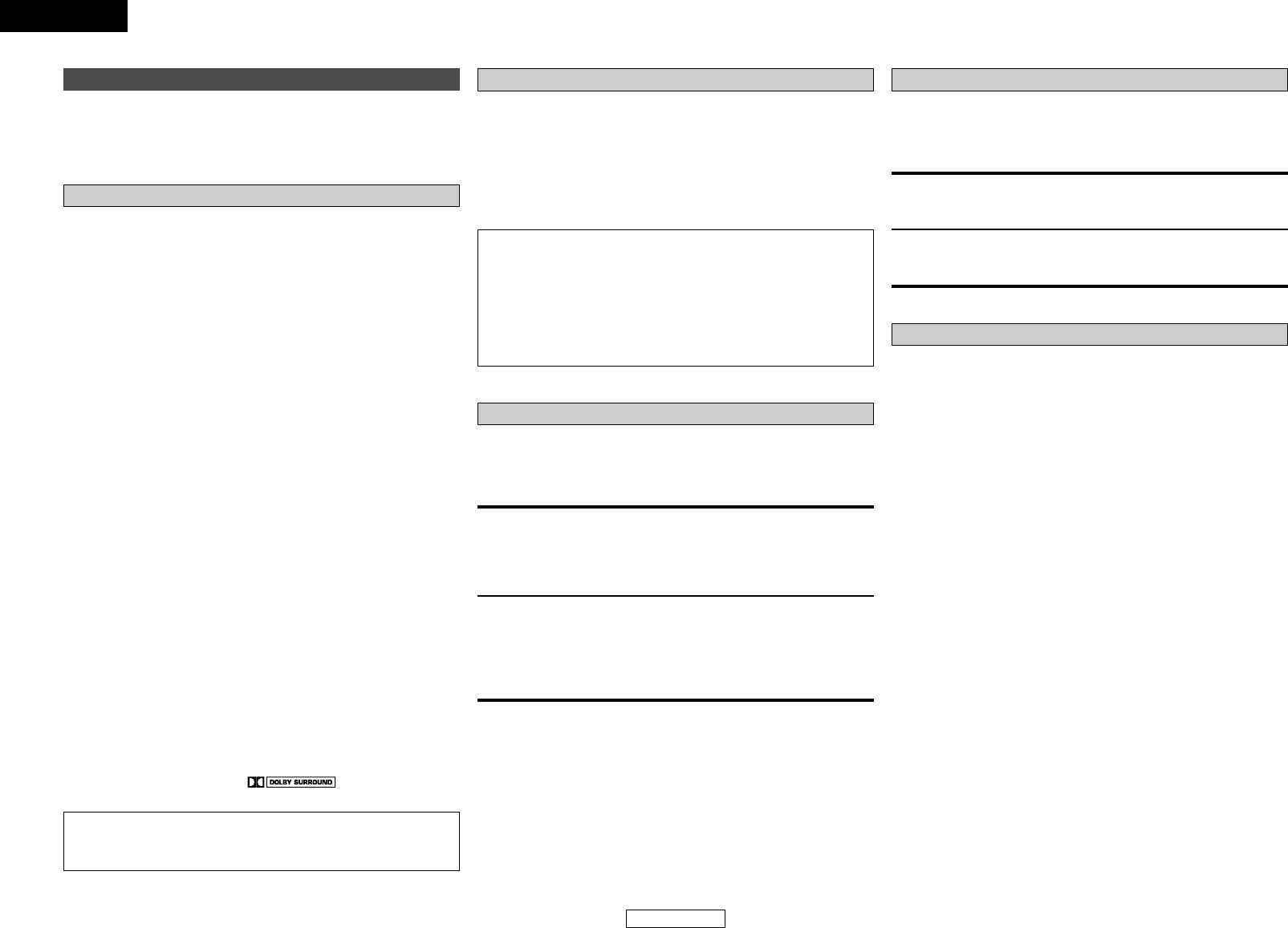
ENGLISH
ENGLISH
71
Additional Information Additional Information
¢Sources recorded in Dolby Surround
Sources recorded in Dolby Surround are indicated with the following
logo marks.
Dolby Surround support mark:
Manufactured under license from Dolby Laboratories. “Dolby”,
“Pro Logic” and the double-D symbol are trademarks of Dolby
Laboratories.
The AVR-2307CI is equipped with a digital signal processing circuit
that lets you play program sources in the surround mode to achieve
the same sense of presence as in a movie theater.
Surround
Dolby Surround
[1] Dolby Digital
Dolby Digital is the multi-channel digital signal format developed by
Dolby Laboratories.
A total of 5.1-channels are played: three front channels (“FL”, “FR”
and “C”), two surround channels (“SL” and “SR”) and the “LFE”
channel for low frequencies.
Because of this, there is no crosstalk between channels and a realistic
sound field with a “three-dimensional” feeling (sense of distance,
movement and positioning) is achieved.
A real, overpowering sense of presence is achieved when playing
movie sources in AV rooms as well.
[2] Dolby Pro Logic II
Dolby Pro Logic II is a matrix decoding technology developed by Dolby
Laboratories. Regular music such as that on CDs is encoded into 5
channels to achieve an excellent surround effect.
The surround channel signals are converted into stereo and full band
signals (with a frequency response of 20 Hz to 20 kHz or greater) to
create a “three-dimensional” sound image offering a rich sense of
presence for all stereo sources.
[3] Dolby Pro Logic IIx
Dolby Pro Logic IIx is a further improved version of the Dolby Pro
Logic II matrix decoding technology.
Audio signals recorded in 2 channels are decoded to achieve a natural
sound with up to 7.1-channels.
There are three modes: “Music” suited for playing music, “Cinema”
suited for playing movies, and “Game” which is optimum for playing
games.
MANUFACTURED UNDER LICENSE FROM DIGITAL THEATER
SYSTEMS, INC.
U.S. PAT. NO’S. 5,451,942; 5,956,674; 5,974,380; 5,978,762;
6,226,616; 6,487,535 AND OTHER U.S. AND WORLD–WIDE
PATENTS ISSUED AND PENDING.
“DTS”, “DTS–ES”, “Neo:6”, AND “DTS 96/24” ARE
TRADEMARKS OF DIGITAL THEATER SYSTEMS, INC. © 1996,
2003 DIGITAL THEATER SYSTEMS, INC. ALL RIGHTS RESERVED.
DTS Digital Surround
DTS Digital Surround is a digital surround format developed by Digital
Theater Systems of the United States.
The number of playback channels and the playing band is the same as
for Dolby Digital (5.1-channels).
The compression rate of the audio data when it was recorded on the
medium is lower than for Dolby Digital, so there is more information
when the data is decoded, resulting in richer, clearer sound quality.
DTS-ES™
DTS-ES is a new surround format developed by Digital Theater
Systems.
A sound image and sense of positioning can be achieved by adding a
surround back (“SB”) channel to the conventional 5.1-channels.
DTS-ES™ Discrete 6.1:
This is the latest format, in which all 6.1-channels, including the
“SB” channel, are recorded independently. Since the different
channels are independent, the sound can be designed with total
freedom.
DTS-ES™ Matrix 6.1:
With this format, the “SB” channel is matrix-encoded and inserted
into the “SL” and “SR” channels, then decoded for the “SL”, “SR”
and “SB” channels upon playback. This achieves a surround sound
more faithful to the artist’s sound design intentions than with
conventional 5.1- or 6.1-channel systems.
DTS NEO:6 surround
This is a matrix decoding technology for 6.1-channel surround playback
of 2-channel sources.
The optimum decoding for the type of signal source to be played can
be selected. There are two modes.
DTS NEO:6 CINEMA:
This mode is suited for playing movies. It achieves the same type of
sound as in a movie theater, even with 2 channels.
DTS NEO:6 MUSIC:
This mode is suited for playing music. A natural sense of expansion
is added to the sound field.
DTS 96/24
DTS 96/24 is a multi-channel digital signal format developed by Digital
Theater Systems.
The sampling frequency is raised to achieve 5.1-channel playback with
high quality sound (sampling frequency: 96 kHz, quantization: 24 bits).


















